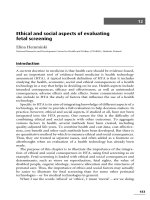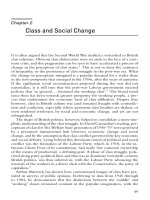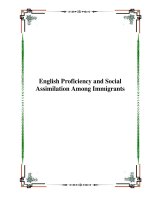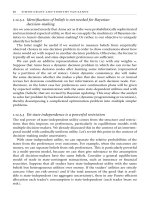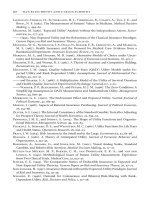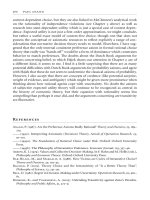CRIME, INVESTIGATION AND SOCIAL RELEVANCE
Bạn đang xem bản rút gọn của tài liệu. Xem và tải ngay bản đầy đủ của tài liệu tại đây (140.58 KB, 18 trang )
UNIT 4 CRIME, INVESTIGATION AND SOCIAL RELEVANCE
In this unit, after some revision activities, we look briefly at the safety of the citizen,
considering the responsibilities of the police to investigate crime.
The unit also highlights the social pressures which the police find themselves under and
some of the factors which lead to successful (or unsuccessful) results.
The race issue- from the troubled times of the 1950s and 1960s in the USA and in
modern Britain- is one that should be taken into careful consideration by anyone studying
crime in contemporary European or American society.
The bombing of a Jewish Temple in Atlanta, Georgia in 1958 and of the Baptist Church
in Birmingham, Alabama in 1963, may not seem to have much to “teach” the
contemporary police officer. However, the issues involved were and are highly complex
and all-too-relevant, as the 2000 case involving the murder of a young Nigerian boy in
London shows.
On a different level, the FBI investigation of fraud connected with murder underlines the
fact that more “white-collar criminals are turning to violence to achieve their ends.”
Exercise 1 Procedures for criminal investigation and prosecution
Complete the words to describe criminal investigation and prosecution procedures
1
. First, the police m…………….. an a…………..
2. The police t………….. the sus…………….. to the police station.
3. Perhaps the police h……………. an identity p…………………
4. The wit……………….. may identify the suspect from an identity p…………….. or from
photographs in the data base – known as criminal rec…………….
5. To help identification of suspects, detectives use computers to construct “identi-kit” or
“ph……………- kit” likenesses of the suspect.
6. In serious crimes, these photographic likenesses may appear on pos ……………
which are displayed outside police stations or in public places.
7. They always int……………….. the sus…………….
8. The police t………………… sam………. – fingerprints, head-hair, dirt from clothes, fibres
etc.
9. The police l…………… a charge as soon as possible.
10. The suspect h……… the right to contact a l …………..
11. The police either rel………… the defendant on bail or, in more serious cases, they
t……………… the defendant before a mag………………. to hold the defendant on
r………….
12. In the court proceedings, the mag…………………… . h…………… the evidence alone in
less serious cases.
13. In more serious cases, there is a jud……………….. who hears the evidence.
Again, in more serious cases, there is a ju………………., usually consisting of 12 members.
The ju …………………….reaches a v…………………………… after hearing all the
ev………………………… .
14. In English law, there are only 2 possible v……………… - “Guilty” or “ Not Guilty”.
15. If the v……………. is guilty, the court (judge or magistrate ) p…………… sen………….
16. The sentence for off………………… is different according to the nature of the offence,
summary or indictable (petty or serious) ( USA ; misdemeanor or felony).
17. The jurisdiction of the courts is diff………….. acc……………… to the nature of the offence,
too.
18. Prisoners who are given cus…………………………. sentences may be sent to
“open” or closed prisons.
19. The first category of prison is reserved for prisoners who have comm………………
less serious offences.
20. “Closed” prisons are for criminals who have comm____________________ serious
offences.
21. Some offenders may be h______________ in “solitary confinement” if they are at
risk from attack by other prisoners. For example, offenders in child abuse or sex
crimes involving children.
22. The death penalty or “cap …………. punishment” does not exist in Britain but is still
used in many states of the United States.
23. Many prisoners are entitled to apply for par……………….. after having
served a certain number of years of their sentence.
24. If the par…………… board (committee) considers the prisoner is not a risk or danger
to the community, he may be released “on par …………..”. He will have to report to
a “par…………….” officer who is usually a “prob……………………officer”.
Exercise 2 Sentence transformations
Rewrite each of the following sentences to mean the same as the sentence printed before it. Use
the words given. Two EXAMPLES are given.
EXAMPLE: You will end up in trouble! Behave yourself!
If ……………………
ANSWER: If you don’t behave yourself you will end up in trouble!
EXAMPLE: Would you like me to call the police?
Shall ………………………………?
ANSWER: Shall I call the police?
1. My advice to you is to call the police.
I think you ……………………………………………………………………
2. The policeman told us to fit new locks on all our doors and windows.
He suggested ………………………………………………………………….
3. The thief didn’t wear gloves so he left a lot of fingerprints.
If the thief …………………………………..……………………………………….
4. Thieves broke into our house when we were on holiday.
Our house ……………………………………………………………………..
5. Please come to the conference!
I’d be grateful ..…………………………………………………………………
6. No, Jerry definitely didn’t steal the jewels. I had the only keys with me.
Jerry couldn’t ………………………………………………………………….
7. The police informed the reporters that the number of crimes had decreased.
The reporters ………………………………….………………………………..
8. Recruiting more police would mean a fall in crime rates!
If we ……………………………………………………………………………
9. It was impossible for them to complete all the paperwork on time!
They ………………………..…………………………………………………..
10. If there is a road traffic accident causing injury the police are obliged to make a full report.
The police …………………………………………………………………………….
Activity 1
Before hearing about a case in England, read the following text and discuss the
issues involved.
Race trail pricks Norway’s Conscience
Andew Osborn, The Guardian Weekly, January 2002
Norway, which fancied itself to be free of the xenophobia which infects other Nordic
societies, has been forced to confront a less palatable reality. The verdict is expected this
week in a trial of three neo-Nazis accused of stabbing a black teenager to death, simply
because they did not like the colour of his skin. Prosecutors demanded the maximum
sentence of 21 years for one man. 19 years and 4 months for another and a lesser sentence
of two and a half years for a third defendant. It is Norway’s first recorded racially
motivated murder.
The killing, which, in the words of the former Prime Minister, Jens Stoltenberg, marked a
“watershed’ in Norway’s history, happened in January 2001. Benjamin Hermansen, a 15
year-old boy of mixed Norwegian-Ghanaian extraction, was attacked only 500 metres
from his home in an Oslo suburb. He died of multiple stabbing wounds and had received
a severe kicking. Joe Erling Jahr, 20, one of the defendants had admitted stabbing
“Benny”, but said he had “ just wanted to give him a scratch” and that the death was an
accident.
But another of the defendants, Veronica Andreassen, 18, told the court that she, Jahr and
a third accused. Ole Nicolae Kvisler, 22, went looking for “foreigners” in their car and
she picked out Benny Hermansen as a perfect target.
Activity 2 Listening
POLICE ACTION UNDER SCRUTINY IN DAMILOLA TAYLOR TRIAL
LISTEN TO THE ACCOUNT OF DAMILOLA TAYLOR’S DEATH
Complete the details in the box
PERSONS
- 6 passersby who …………………………
…………………………………………….
…………………………………………….
- 3 youths …………………………………
…………………………………………….
…………………………………………….
- Mr Mark Parsons ………………………..
…………………………………………..
…………………………………………..
…………………………………………..
- Maynard Cox George ……………………
…………………………………………
…………………………………………
- Mohammed El-
Nagdy…………………………………………
…………………………………………………
…………………………………
- Jordan
Fayemi……………………………………
…………………………………………………
………………………………………
- Superintendent Rob Jarman
…………………………………………………
………………………………………
- Gloria Taylor …………………………………
………………………………………………………
TIMES/DATES
- four months ago (August 2000) ……………
………………………………………………
- 4:45 p.m
………..…………………………….…………
……………………………….……..
- 5 p.m.
…………………………………………………
………………………………………
- “minutes later” …………………………..
……………………………………………
PLACES
- stairwell in the council apartment block
…………………………………………….
…………………………………………….
- North Peckham Estate
……….………...………………………………
…………………………………
- Oliver Goldsmith Primary School
…………………………………………………
…………………………………
- Blakes Road …………………………
……………………………………….
ENVIRONMENT
- housing estate (council blocks)……………….
…………………………………………………
…………………………………………………
- street lighting …………………………………
………………………………………………..
………………………………………………..
- rubbish chute …………………………………
………………………………………………..
OFFENCES AND ANTI-SOCIAL
ACTIVITIES
- bullying
…………………………………………………
…………………………………
- stabbing
…………………………………………
…………………………………………
- stealing
………………………………………...
………………………………………...
- taunts (racist or “You’re gay!”)
………………………………………...
………………………………………...
- attack (assault)
………………………………………..
………………………………………..
Activity 3 A Racist Crime?
What’s your opinion?
AGREE OR DISAGREE?
1. The crime had racist overtones.
2. The suspects were also victims of their environment.
3. The school should have taken the bullying of Damilola more seriously.
4. The police should have been more vigilant in such a high-risk area.
5. The local people should have been more aware of the need to protect their
community.
6. The planning of such housing estates should be much more carefully
done.
7. Such a murder emphasises the inherent racism in British society.
8. The fact that the family got an apartment from the Council shows the
positive side of British society.
9. The family should have been more careful, knowing the risks of racist
attacks in London.
10. The perpetrators should be kept in prison for life.
11. Public opinion will have been shocked by this murder.
12. The police will have a relatively easy task in finding the offenders.
Activity 4
Consider the vocabulary items in the box. How many of these words would you consider
to be absolutely essential “core vocabulary” for your own language progress?
VOCABULARY
1. bleak: miserable, unpleasant, unattractive
2. to taunt: provoke or attack a person with words; abuse verbally
3. drenching: making very wet
4. to stem: stop the flow of (blood)
5. to piece together : to put the pieces (of the incident) together
6. to be slashed: to be cut through very badly
7. to settle (down); to adjust to a different way of life or different environment
8. bulldozed: to be made flat by bulldozers
9. to swear at someone : to use vulgar or obscene language at someone
10. to call someone names: to abuse someone verbally
11. to take something seriously: to consider something to be serious
12. to bump into: to meet someone by chance
13. a black eye: the wound resulting from a blow or punch in the eye
14. to sift through: to examine very carefully
15.
rubbish chute: rubbish disposal system in the apartment blocks
Activity 5
Now read the following text for more recent developments
POLICE ACTION UNDER SCRUTINY IN DAMILOLA TAYLOR TRIAL
Astrid Zweynert, Reuter February 27 2002
Police have suffered another blow when a judge cleared a defendant on trial for the
murder of Damilola Taylor and threw out the evidence of the prosecution’s main witness.
The judge criticised the police for breaking rules and offering inducements to their key
witness, a 14 year-old schoolgirl, which had contributed to making her evidence
unreliable.
The defence said officers gave the girl clothes and mobile phones and told her she was
more likely to get a ₤50000 newspaper reward if she said she saw the killing, as police
believe she did. Justice Anthony Hooper said there was “a very real danger” that
detectives persuaded the girl to tell lies when they offered her the inducements to
convince her to give evidence in court. “No part of the evidence which is adverse to any
defendant can be relied upon,” Justice Hooper told the jury at London’s Old Bailey.
Even though the trial against the other three juvenile defendants continues, Wednesday’s
ruling once again put the spotlight on police practices in high-profile cases.
A government report in 1999 lashed the Metropolitan Police for its bungled investigation
into the murder of black teenager, Steven Lawrence, who was stabbed to death by a gang
of white youths in 1993 as he waited at a bus stop. His killers have never been brought to
justice. Both cases sparked soul-searching in Britain and led to calls for a crackdown on
gang violence and thuggery.
Police chiefs say the force has worked hard to clean up its image, but the pressure to
solve crime is acute as street crime in the capital rockets, with figures in January 2002
49% higher than a year before.
Cortenay Griffiths, QC, a defence lawyer in the Taylor case, told the court that police had
“manufactured” the schoolgirl to become their “star” witness because they could not
afford another unsolved murder like that in the Lawrence case.
Griffiths said criticism aimed at the police after the Lawrence enquiry had motivated
officers to “break every rule in the book” in their handling of the schoolgirl, who cannot
be named for legal reasons. The defence said officers had told the girl that she could help
one of the defendants, who was her friend, by saying she saw the killing. According to
the defence, she was also told that reward money offered by a newspaper would be “more
guaranteed” if she said she had witnessed the murder.
Defence lawyers produced evidence that she and her mother had run up a ₤ 4100 hotel
bill before the trial and that police had bought her clothes, mobile phones and had paid
₤ 1000 of telephone calls to her friends.
Police admitted to the hotel bills and to buying the girl clothes and giving her two mobile
phones, but denied that this was meant to entice her into giving evidence at the trial.
Exercise 3
Read the text and answer the questions: TRUE or FALSE or NOT CLEARLY STATED
1. The police offered rewards to the girl to give false evidence.
2. The judge stated that the police acted in a way that made the truth more difficult to
identify.
3. Some of the main witness’s evidence may still be used in court.
4. Police inducements to the girl had included money payments to her and her mother.
5. The girl was related to one of the accused.
6. Police chiefs say that the image of the Metropolitan Police is not compromised as
people are generally satisfied because of the falling crime rate.
7. Criticism of the police over their conduct in the Stephen Lawrence case has meant
that police are under pressure to solve the Taylor case by any means.
8. The hotel bills involved friends staying with the girl.
9. The trial itself is now compromised and the case may be dismissed.
10. The police hope there will be a more successful outcome to this case than to the
Lawrence case.
11. The girl has already been promised money by a newspaper for her story
12. One of the accused has been released as a result of the fact that her evidence is
unreliable.
Exercise 4
Find words from the text in the box which mean …
inducements/ blow / adverse / soul-searching / rockets / run-down
ambushed/ put the spotlight on / high-profile / bungled / lashed / entice /
be relied on
A. a setback; a reversal ( suffer a …..)
B. to encourage someone by offering something; to tempt a person (Verb)
C. extremely important, especially for the media
D. attacked without any warning; (a surprise attack)
E. harmful to ; against a person
F. to focus carefully on something or somebody
G. increases rapidly
H. examination of people’s values, attitudes and priorities
I. criticised very severely
J. offers or rewards given to a person for information, help or support
K. in a very poor condition; neglected
L. badly handled or managed
M. to be counted on; to be believed


